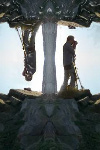© 2012 Iñaki Rezola, All Rights Reserved.
But at the same time and along with it all, there is something more to it: there is the Colosseum.
Of course, it is a must, something you've got to see when you first visit Rome, one of the biggest ancient buildings, full of marble and sculptures at that time. But it is also a reminder: how not to think of the thousands of people killed there for centuries just for other people's entertainment? And not to be self indulgent, let's take a look at our most recent history: how good did their brilliant 20th Century culture do to prevent the civilized Europeans from committing any kind of horror at all?
Where is the failure?
Pero con todo ello y al mismo tiempo, hay algo más: el Coliseo.
Por supuesto, es una visita obligada cuando se va a Roma por primera vez: es una de las mayores edificaciones de la antigüedad, cubierta en su época de mármoles y esculturas. Pero es también un aviso: ¿cómo no pensar en los miles de personas que murieron allí durante siglos para entretener a otros? Y para no caer en la autoindulgencia, echemos un vistazo a nuestra historia reciente: ¿les impidió su brillante cultura cometer algún tipo de atrocidad a los europeos del siglo XX?
¿Dónde está el fallo?
Bainan horrekin guztiarekin ere, badago beste zerbait: Koliseoa
Erromarako lehenengo bisitaldian derrigorrez ikusi beharrekoa da, noski: antzinateko eraikuntzarik handienetakoa izanda, marmolez eta eskulturaz estalita zegoela bere garaian, nola ez ikusi? Hala ere, badu beste zerbait; abisua: nola ez pentsatu bertan hil ziren milaka pertsonengan... beste batzuen denborapasa hutsarako? Eta gure buruaz errezegi ez harrotzeko horien kontura: XX. mendeko europear kultur distiratsuak nola ez zuen ekidin Europako bazter guztietan ikusitako desastre eta beldurgarrikeriak?
Non dago okerra?



 Tap or click the zoom icon in the bottom right corner of the picture to switch between in-page and fullscreen view
Tap or click the zoom icon in the bottom right corner of the picture to switch between in-page and fullscreen view